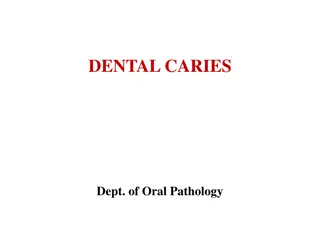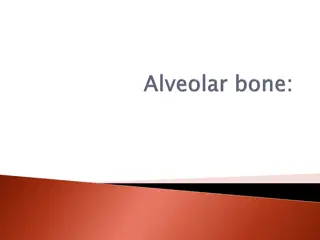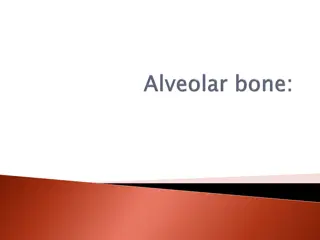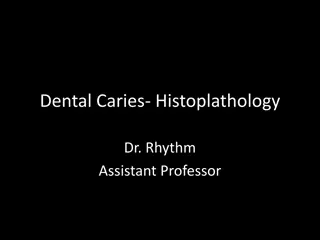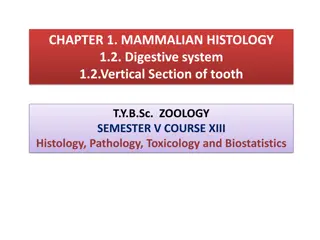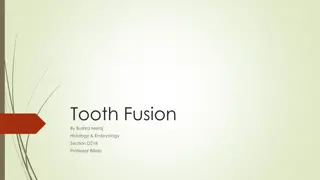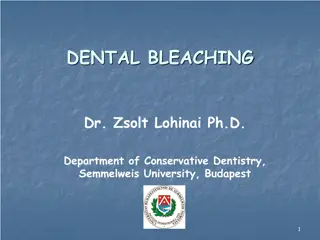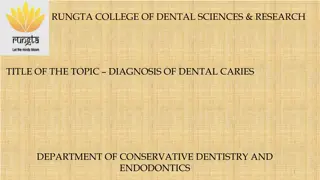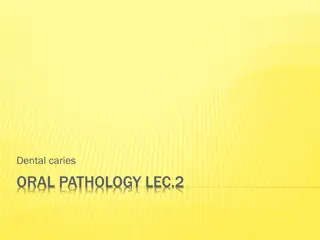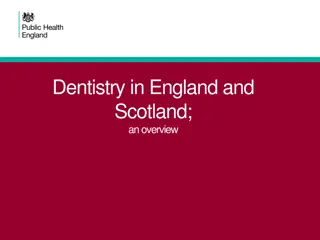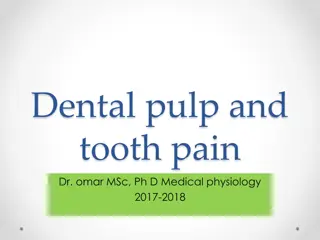Understanding Dental Caries Development and Factors Affecting Tooth Decay
Dental caries, commonly known as tooth decay, is a result of localized chemical dissolution of the tooth surface due to metabolic events in the biofilm. Factors like host susceptibility, plaque formation, diet, and time play a crucial role in the carious process. Tooth morphology, position of teeth, and other oral cavity areas impact the likelihood of caries development. This comprehensive guide sheds light on the multifactorial nature of dental caries and provides insights into prevention strategies.
Download Presentation

Please find below an Image/Link to download the presentation.
The content on the website is provided AS IS for your information and personal use only. It may not be sold, licensed, or shared on other websites without obtaining consent from the author. Download presentation by click this link. If you encounter any issues during the download, it is possible that the publisher has removed the file from their server.
E N D
Presentation Transcript
Dental caries development Dr. Rihab Abdul Hussein Ali B.D.S , M.Sc. , PhD.
The term dental caries (tooth decay or cavity) is used to describe the results (the signs and symptoms) of a localized chemical dissolution of the tooth surface caused by metabolic events taking place in the biofilm (dental plaque) covering the affected area. It is a multifactorial disease characterized by demineralization of the mineral components and dissolution of the organicmatrix . The destruction can affect enamel, dentin and cementum.
Carious process is the result of an interaction of the following: 1- Host. 2- Plaque. 3- Diet. 4- Time.
Factors affecting caries process: 1- Host Factor: This involves susceptible tooth and saliva. Tooth: Several factors affecting tooth susceptibility: 1- Morphology of teeth: Dental caries lesions may develop at any tooth site in the oral cavity where a biofilm develops and remains for a period of time. Such sites include pits, grooves and fissures in occlusal surfaces, proximal surfaces cervical to the contact point/area and along the gingival margin. These are the sites where lesion development is more likely to occur because the biofilm is allowed to stagnate there for prolonged time.
Other areas in the oral cavity are relatively protected from dental caries due to the mechanical influence from the tongue, the cheeks, abrasive foods and tooth brushing but the insertion of foreign bodies to the dentition (e.g. fillings with inappropriate margins, dentures, orthodontic bands) may also result in dental caries in these protected sites. Certain surfaces of a tooth are more prone to caries whereas other surfaces rarely show caries. For example, in mandibular 1st molars the caries in descending order is occlusal, buccal, mesial, distal and lingual. The differences in caries rates of various surfaces on the same tooth are in part due to morphology.
2- Position of teeth: Anterior teeth are less affected by dental caries compared to posterior teeth. The most susceptible permanent teeth are the mandibular first molars, followed by the maxillary first molars and the mandibular and maxillary second molars. The second premolars, maxillary incisors and first premolars are the next in sequence. While the mandibular incisors and canines are the least susceptible teeth to develop caries.
3- Composition of teeth: The tooth is composed mainly of inorganic elements (96% in enamel and 70% in dentin) and the remaining are organic materials and water. Composition of teeth is affected by environmental factors (water, diet and nutrition). Inorganic components involve: Major elements: calcium, phosphorous, hydroxyl group {Ca10 (PO4)6(OH)2} hydroxyapatite crystals.
Minor elements: Zinc, copper, strontium, magnesium, fluoride, etc. These elements may incorporate the tooth during tooth formation or incorporate the outer enamel surface later after eruption. Furthermore, these elements may incorporate the enamel crystal in substitutions with one of its major elements. Some of these elements may increase the resistance to caries like fluoride, zinc and others.
While other elements such as magnesium may increase the susceptibility of teeth to caries. It had been found that substitution of hydroxyl group by fluoride ion results in formation of fluoroapitite crystals {Ca10 (PO4)6F2} that increase tooth resistance to caries. The accumulation of these elements will results in changes of the enamel (decrease in density and permeability, an increase in fluoride content) with age.
The organic constituents and water of both enamel and dentin may act as a diffusion pathway for bacterial acids increasing the tooth destruction. In other way, they permit the penetration of ions for physiological remineralization- demineralization process. Such voids in enamel as well as proteins act as a caution for intense biting pressure to prevent fracture.
Saliva: Through its secretion and composition affects dental caries development. It can affect the number of microorganisms through cleansing action (oral clearance), While buffer system in saliva affects the integrity of teeth as well as calcium and phosphate.
2- Dental plaque: The cariogenic bacteria in plaque consist of mutans streptococci, lactobacilliand other types. Bacteria ferment carbohydrate causing release of acid lead to demineralization of tooth surface. Plaque accumulation may show individual variations and affected by many factors such as age and practices of oral hygiene.
Diet: It may exert an effect on caries locally in the mouth by reacting with the enamel surface and by serving as a substrate for cariogenic microorganisms. Frequent consumption of sweets between meals lead to continuous drop of pH, thus demineralization will occur.
Terminology of caries Dental caries may be classified in a number of ways, according to their anatomical sites. Primary caries is used to differentiate lesions on natural, intact tooth surfaces from those that develop adjacent to a filling material. Recurrent or secondary caries is a lesion developing at a tooth surface adjacent to a filling. Pits and fissures caries is a lesion affected pits and fissure sites of tooth surfaces. Smooth surfaces caries is lesion that may start on smooth enamel as buccal/labial or interproximal surfaces
Arrested caries is a lesion that may have formed years previously and then stopped further progression. Rampant caries is the name given to multiple active carious lesions occurring in the same patient. Nursing bottle caries is one type of rampant caries in the primary dentition of infants and young children, result from a sleep sucking bottle. Root caries is lesion on the exposed root cementum and dentin.
Dynamics Process of De-/Remineralization Dental caries is a disease that is manifested as a dynamic process of de/remineralization in the mouth (Enamel sieve concept). The first stage of demineralization is occurring at the atomic level far before it can be seen visually as gross demineralization. During this step, fermentable carbohydrates are metabolized by bacteria in dental plaque to produce organic acids.
These acids diffuse into the dental hard tissue through the water among the crystals and could reach a susceptible site on a crystal surface. Calcium and phosphate are dissolved into the surrounding aqueous phase between the crystals. This is considered as the first step in the progress of the dental caries process which can eventually lead to cavitation. The oral fluids (saliva, biofilm fluid) have calcium (Ca) and phosphate (P) in supersaturated concentrations with respect to the mineral composition of enamel. At physiological conditions (a neutral pH of 7), low ion concentrations are sufficient to keep dental hard tissues in equilibrium.
If the pH drops because of acid produced by the dental plaque, higher ion concentrations are needed to prevent dissolution of dental hard tissue. Calcium (Ca) and phosphate (P) ions are continually deposited on the enamel surface or redeposit in enamel areas where they were lost. At a pH of 5.5, under saturation begins, that is, the calcium and phosphate ion concentrations in the plaque fluid are not sufficient to maintain the enamel in stable equilibrium; thus, the enamel starts to dissolve.
Demineralization is a continual imbalance between pathological and protective factors that results in the dissolution of apatite crystals and the net loss of calcium, phosphate, and other ions from the tooth. The term remineralization is used to describe mineral gain. Remineralization is the body s natural repair process for subsurface non-cavitated carious lesions. In the process of remineralization, calcium and phosphate ions are supplied from a source external to the tooth to promote ion deposition into crystal voids in demineralized enamel to produce net mineral again.
De-/remineralization cycles continue in the mouth as long as there are factors including cariogenic bacteria, fermentable carbohydrates, and saliva. The balance between pathological factors and protective factors determines whether demineralization or remineralization is proceeding at any one time.
The development of a carious lesion occurs in three distinct stages: The earliest stage: Itis the incipient lesion; macroscopically evidenced on the tooth surface by the appearance of an area of opacity (the white spot lesion), which is accompanied by histologic changes of the enamel at the microscopic level and is well established with a number of recognizable zones.
The second stage: Itincludes the progress of the demineralization front toward the dentino-enamel junction and/or into the dentin; the affected dentin displays discoloration from brown to dark brown or black, microscopic changes of dentin showed different zones. The final phase: It is the development of the overt or frank lesion, which is characterized by actual cavitation.





